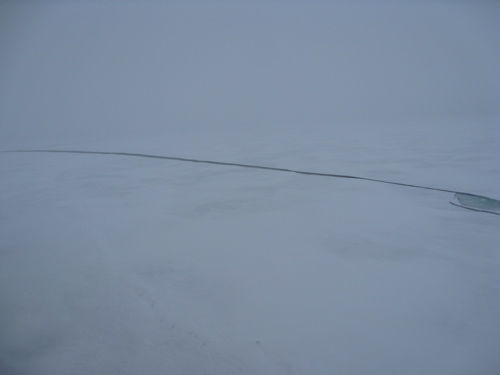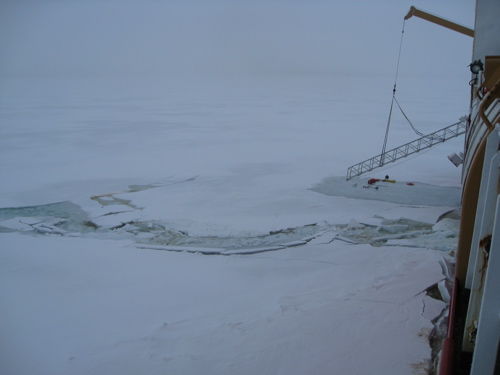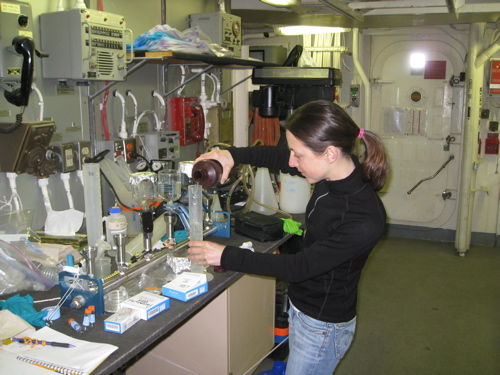Latitude: 61 46.025 N Longitude: 168 55.005 W
The Captain had already briefed us on the potential ice hazards. Everyone had wiggled and pulled, squirmed and struggle to suit up in our MSD900 exposure suits. The sleds had been loaded up with heavy equipment and some materials had already been hand-lowered onto the ice. The final step was to descend the brow.The crack must have started small. Maybe it was just a little hairline fracture across an otherwise perfectly frozen sheet of sea ice. By the time it reached the stern though it had grown to a couple feet wide and as it crept along the portside of the ship it widened even further.
 As the crack got closer to the boat, (and our ice station!), it began to widen.
As the crack got closer to the boat, (and our ice station!), it began to widen.
The area that we were about to descend upon quickly went from looking like just the right spot to a near disaster. Three Coast Guard crewmembers were already on the ice as was some of the equipment when the sheet began to break into pieces that bobbed in the freezing seawater.
 The sea ice gave way right below the brow. You can see here that the caved in part is right near where we were set to step down on the ice. The brow looks small next to the break. That's actually a big ramp!
The sea ice gave way right below the brow. You can see here that the caved in part is right near where we were set to step down on the ice. The brow looks small next to the break. That's actually a big ramp!
Luckily, no one was hurt. Thanks to quick thinking and training on the part of the crew, both the people and the equipment were brought safely aboard.
Our hopes of working on the ice were thankfully, not dashed. We moved to the next ice floe about a half-mile away and waited to see what would happen. After an hour of stable ice, the brow was lowered and this time we were able to get on with the research. I worked with the Iken team again collecting ice samples.
When we got back to the lab- ice madness gave way to mad science. Much of what the scientists on this boat study is too small to be seen with the naked eye. One of the ways that information can be gained about what kind of material is suspended in the water without being able to see it at first glance is to filter the water. Using glass filters that catch nearly everything except the water itself, the organic matter can be separated and different parts can be studied. There are many different contraptions for filtering water around the lab. Katrin Iken's filtration system looks like something straight out of Mr. Wizard or Bill Nye the Science Guy's lab. Check out what it looks like below! Here, I am filtering water from samples taken from the CTD.
 Careful measurements must be made to find out how much water is in each bottle to be filtered. Can you see how I am measuring it? Graduated cylinder- just like you use!
Careful measurements must be made to find out how much water is in each bottle to be filtered. Can you see how I am measuring it? Graduated cylinder- just like you use!
Once work was done for the day we all headed to the "No-Talent Show". As part of the rituals that take place when the International Date Line is crossed, those who had never nautically crossed the line before are asked to perform. Thankfully, I have no footage to share with you of myself Bollywood dancing to the finale of Slumdog Millionaire. You can use your imagination and I'm sure that it will be less embarrassing! ☺ Saturday is Bingo night on the ship. We are back on the ice tomorrow! Fingers still crossed for a bear sighting! Keep you posted!

